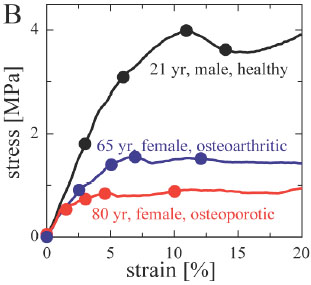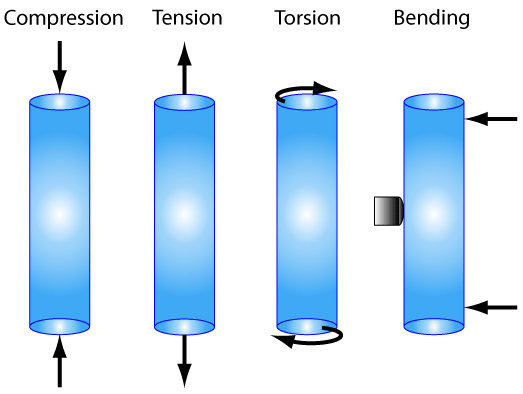class: center, middle, inverse, title-slide .title[ # Lecture 7 ] .subtitle[ ## Coarse Materials II ] .author[ ### Dr. Christopher Kenaley ] .institute[ ### Boston College ] .date[ ### 2025/2/4 ] --- class: inverse, top # Material Properties of the Dead, Toughness, and Resilience <!-- Add icon library --> <link rel="stylesheet" href="https://cdnjs.cloudflare.com/ajax/libs/font-awesome/5.14.0/css/all.min.css"> .pull-left[ Today we'll .... - Consider material properties going way back - Consider toughness - Considier resilience ] .pull-right[   ] --- class: top # Material and structures .pull-left[ - Loads and deformations -- basic concepts - Stress: the distribution of force over an area - Strain: a dimensionless measure of deformation - Stiffness: a measure of how materials respond to stress (or strain) - Loads: the relationship between stress and strain - Strength: the stress at breaking ] .pull-right[  ] --- class: top # Material and structures .pull-left[ - All (biological) materials respond to external forces by deforming - We seek a way to understand and characterize these responses - Material behavior as separate from structural behavior - We will formalize the relationships between force and deformation ] .pull-right[  ] --- class: top # Material properties ## Types of deformation .center[ ] .center[  ] --- class: top # Material properties ## Types of deformation .pull-left[ Stress: `$$\sigma=\frac{F}{A}$$` `\(Pa=N\cdot m^2\)` Strain `$$\varepsilon=\frac{L-L_o}{L_o}$$` Units? ] .pull-right[ <img src="img/loads.png" width="350" /> ] --- class: top # Material properties .pull-left[ `$$stress(\sigma)=\frac{F}{A}$$` <img src="img/strainarrows.png" width="350" /> Young's modulus: `\(E=\frac{\sigma}{\varepsilon}\)` What are units of `\(E\)`? ] .pull-right[ `\(strain(\varepsilon)=\frac{L-L_o}{L_o}\)` Hook's law: `\(F=K\Delta L\)` <img src="img/stressstrainstiff.png" width="350" /> ] --- class: top # Material properties .pull-left[ `\(\sigma\)`: distribution of force over and area `\(\varepsilon\)`: dimensionless measure of length of change stiffness (E): change in stress relative to strain (slope of stress-strain curve) <img src="img/tendoncurve.png" width="250" /> ] .pull-right[ `\(\sigma_{max}\)`: Strength, max stress applied without failure or plastic deformation. Most biological materials are non-linearly elastic <img src="img/bonehaircurve.png" width="250" /> ] --- class: top # Material properties .pull-left[ `\(\sigma\)`: distribution of force over and area `\(\varepsilon\)`: dimensionless measure of length of change stiffness (E): change in stress relative to strain (slope of stress-strain curve) <img src="img/tendoncurve.png" width="250" /> ] .pull-right[ `\(\sigma_{max}\)`: Strength, max stress applied without failure or plastic deformation. Most biological materials are non-linearly elastic <img src="img/failuretable.png" width="250" /> ] --- class: top # Material properties .pull-left[ `\(\sigma\)`: distribution of force over and area `\(\varepsilon\)`: dimensionless measure of length of change stiffness (E): change in stress relative to strain (slope of stress-strain curve) <img src="img/stressstraincurve.jpg" width="350" /> ] .pull-right[ Most biological materials are non-linearly elastic <img src="img/failuretable.png" width="250" /> ] --- class: top # A comparison of E across domains .center[ <img src="https://d3i71xaburhd42.cloudfront.net/1eb86e8732a38a0753510236e5c023b5decd5340/7-Figure7-1.png" width="500" /> ] --- class: top # Materials and the largest among us .center[ ### Are land animals constrained by the strength of bone? <img src="https://upload.wikimedia.org/wikipedia/commons/3/34/Longest_dinosaurs2.svg" width="700" /> ] --- class: top # Materials and the largest among us .center[ <img src="https://upload.wikimedia.org/wikipedia/commons/2/2f/Patagotitan_vs_Mammals_Scale_Diagram_SVG_Steveoc86.svg" width="700" /> ] .pull-left[ Baluchitherium weighed about 30 Tons (27000 kg) - Could the foot bones support its weight? - `\(\sigma_{max} = \textrm{100 MPa } (10^{6} \textrm{ Pa})\)` - Diameter = 14 cm - `\(\textrm{CSA} = \textrm{151 10}^{-4} \textrm{ m}^2\)` ] .pull-right[ <img src="https://upload.wikimedia.org/wikipedia/commons/thumb/a/ab/Indricotherium_transouralicum_hind_foot.jpg/170px-Indricotherium_transouralicum_hind_foot.jpg" width="150" /> ] --- class: top # Materials and the largest among us .center[ <img src="https://upload.wikimedia.org/wikipedia/commons/2/2f/Patagotitan_vs_Mammals_Scale_Diagram_SVG_Steveoc86.svg" width="700" /> ] .pull-left[ Baluchitherium weighed about 30 Tons (27000 kg) - Could the foot bones support its weight? - `\(\sigma_{max} = \textrm{100 MPa } (10^{6} \textrm{ Pa})\)` - Diameter = 14 cm - `\(\textrm{CSA} = \textrm{151 10}^{-4} \textrm{ m}^2\)` ] .pull-right[ `\(\sigma_{max} \geq \frac{9.8\cdot27000}{151\cdot10^{-4}}\)` `\(\sigma_{max} \geq \textrm{= 17 MPa}\)` ] --- class: top # Materials and the largest among us .center[ ### But what about these guys? <img src="https://upload.wikimedia.org/wikipedia/commons/3/34/Longest_dinosaurs2.svg" width="700" /> <img src="https://static.scientificamerican.com/blogs/cache/file/23C1EE59-CC6F-4542-A5EAACB8E6336F06_source.jpg?w=590&h=800&D6BDF76C-BA43-435B-A12E3263F71F10FF" width="400" /> ] --- class: top # Materials and the largest among us .center[ ### But what about these guys? <img src="https://upload.wikimedia.org/wikipedia/commons/3/34/Longest_dinosaurs2.svg" width="700" /> How agile were they? Design a comparative research project to assess this ] + What level of agility would impose larger/smaller GRFs and stresses? + What properties of the bones would you study? + What species would be part of your comparative program? --- class: top # Materials and the largest among us .center[ <img src="largebone.png" width="400" /> ] --- class: top # Toughness .center[ ### The energy imparted is the **mechanical strain energy** that can be returned or be so great as to break the material ] .pull-left[ .center[ `\(U=\int\sigma d\varepsilon\)` ] <img src="img/toughness.png" width="350" /> ] .pull-right[ `\(T=\int\sigma d\varepsilon\)` **Toughness:** the energy per unit volume required to break a material ] --- class: top # Toughness .center[ ### Some (but not necessarily all) of the mechanical energy can be returned ] .pull-left[ .center[ `\(U=\int\sigma d\varepsilon\)` ] <img src="https://static.cambridge.org/binary/version/id/urn:cambridge.org:id:binary:20191021053530314-0709:9781108686624:72215fig26_6b.png?pub-status=live" width="350" /> ] .pull-right[ **Resilience (R)**= `$$\frac{\textrm{strain energy returned}}{\textrm{strain energy absorbed}}$$` <table> <thead> <tr> <th style="text-align:left;"> material </th> <th style="text-align:left;"> R </th> </tr> </thead> <tbody> <tr> <td style="text-align:left;"> Silk </td> <td style="text-align:left;"> 35% </td> </tr> <tr> <td style="text-align:left;"> Elastin </td> <td style="text-align:left;"> 76% </td> </tr> <tr> <td style="text-align:left;"> Abductin </td> <td style="text-align:left;"> 80% </td> </tr> <tr> <td style="text-align:left;"> Collagen (tendon) </td> <td style="text-align:left;"> 93% </td> </tr> <tr> <td style="text-align:left;"> Resilin (wing hinge) </td> <td style="text-align:left;"> 97% </td> </tr> </tbody> </table> ] --- class: top # Resilience in the vertebrate body ### The cardiovascular system? --- class: top # Resilience in the vertebrate body ### The cardiovascular system? .center[ <img src="https://bookdown.org/jcog196013/BS2001/_book/_main_files/figure-html/sysdias.PNG" width="400" /> ] --- class: center, middle # Thanks! Slides created via the R package [**xaringan**](https://github.com/yihui/xaringan).